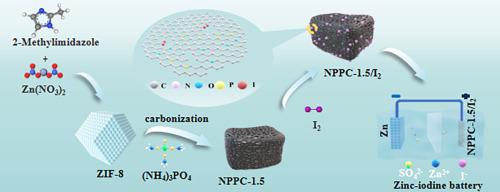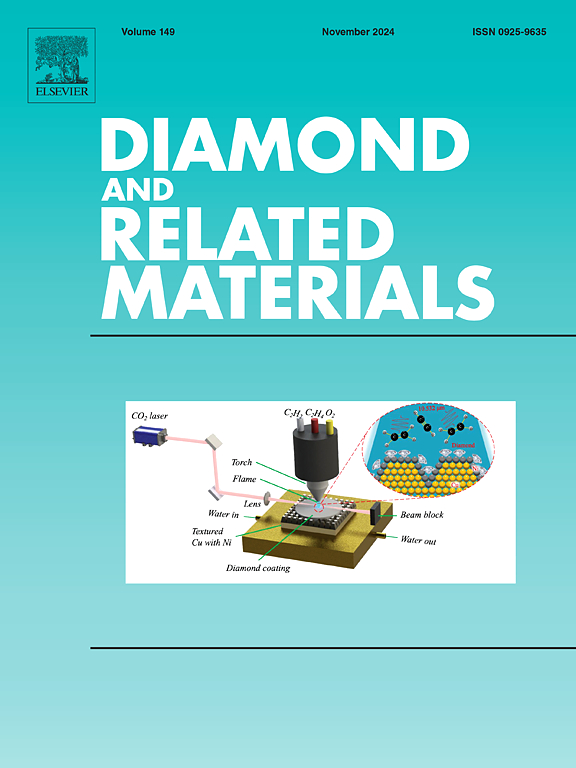利用高氮、磷共掺杂多孔碳框架包裹聚碘化物,实现高性能锌碘电池
IF 4.3
3区 材料科学
Q2 MATERIALS SCIENCE, COATINGS & FILMS
引用次数: 0
摘要
可充电锌碘水溶液电池(ZIBs)对环境影响小,且天然储量丰富,已成为前景广阔的电化学储能装置。然而,穿梭效应和低电导率导致其电化学性能较差,阻碍了其实际应用。本文提出了一种 (NH4)3PO4 活化的 ZIF-8 衍生多孔碳 (NPPC),用于在 ZIB 中夹带碘物种。得益于其丰富的多孔结构和高导电性框架,NPPC 的碘负载和电子传输能力大大增强。此外,在碳框架中原位掺杂多个杂原子(N、P 和 O)还能与碘物种建立化学锚定,从而减轻穿梭效应。因此,由 NPPC-1.5/I2 电极制备的 ZIB 在 0.1 A g-1 的条件下实现了 175 mAh g-1 的超高比容量,在 10 A g-1 的高电流密度条件下实现了 95 mAh g-1 的比容量。在 10 A g-1 条件下循环使用 6000 次后,还能获得 97% 的容量保持率,循环性能极为稳定。这项研究为实现具有高容量和长循环寿命的水性 ZIB 提供了一种新策略。本文章由计算机程序翻译,如有差异,请以英文原文为准。

Entrapping polyiodide by using highly N, P co-doping porous carbon framework towards high performance zinc‑iodine batteries
Rechargeable aqueous zinc‑iodine batteries (ZIBs) with low environmental impact and abundant natural reserves have become promising electrochemical energy storage devices. However, the shuttle effect and low conductivity lead to poor electrochemical performance, hindering their practical applications. Herein, a (NH4)3PO4-activated ZIF-8-derived porous carbon (NPPC) is proposed for entrapping iodine species in ZIBs. Benefiting from its abundant porous structure and highly conductive framework, the iodine loading and electron transport of NPPC is greatly enhanced. In addition, the in-situ doping multiple heteroatoms (N, P and O) in the carbon framework can also establish chemical anchoring with iodine species and hence mitigate the shuttle effect. As a result, the ZIBs prepared by the NPPC-1.5/I2 electrode achieves an ultra-high specific capacity of 175 mAhg−1 at 0.1 A g−1, and a specific capacity of 95 mAh g−1 at a high current density of 10 A g−1. An extremely stable cycle performance of 97 % capacity retaining after 6000 cycles at 10 A g−1 is also obtained. This study provides a new strategy for realizing aqueous ZIBs with high capacity and long cycling life.
求助全文
通过发布文献求助,成功后即可免费获取论文全文。
去求助
来源期刊

Diamond and Related Materials
工程技术-材料科学:综合
CiteScore
6.00
自引率
14.60%
发文量
702
审稿时长
2.1 months
期刊介绍:
DRM is a leading international journal that publishes new fundamental and applied research on all forms of diamond, the integration of diamond with other advanced materials and development of technologies exploiting diamond. The synthesis, characterization and processing of single crystal diamond, polycrystalline films, nanodiamond powders and heterostructures with other advanced materials are encouraged topics for technical and review articles. In addition to diamond, the journal publishes manuscripts on the synthesis, characterization and application of other related materials including diamond-like carbons, carbon nanotubes, graphene, and boron and carbon nitrides. Articles are sought on the chemical functionalization of diamond and related materials as well as their use in electrochemistry, energy storage and conversion, chemical and biological sensing, imaging, thermal management, photonic and quantum applications, electron emission and electronic devices.
The International Conference on Diamond and Carbon Materials has evolved into the largest and most well attended forum in the field of diamond, providing a forum to showcase the latest results in the science and technology of diamond and other carbon materials such as carbon nanotubes, graphene, and diamond-like carbon. Run annually in association with Diamond and Related Materials the conference provides junior and established researchers the opportunity to exchange the latest results ranging from fundamental physical and chemical concepts to applied research focusing on the next generation carbon-based devices.
 求助内容:
求助内容: 应助结果提醒方式:
应助结果提醒方式:


